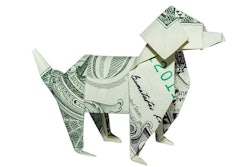
Sales of plant-based human food increased 27% in 2020, reaching US$7 billion, according to SPINS data shared by the Good Food Institute and Plant Based Foods Association, and reported by GroceryDive.com. The plant-based category grew at a higher rate than most “traditional” human foods, even as U.S. consumers bought more food during the pandemic.
Plant-based growth has continued in 2021, at least through July, the most recent data provided. So it’s no surprise that plants are appearing on lists of top human food trends for 2022, continuing their high rankings for a few years now.
For example, multi-conglomerate ADM ranked “plant-based lifestyles” second on its list of eight top global consumer trends for 2022; “plant-based: canvas for innovation” also ranked second on Innova Market Insights annual trends list. (Watch this blog for more on Innova’s top 10 trends for 2022 soon.)
Interplay between human food and pet food
Interestingly, ADM’s trends list also included humanization of pets at number five. That’s not news to anyone in the pet food industry; humanization has been a force for at least 15 years now, rising to the level of a (the?) foundation for the industry’s ongoing growth.
In other words, it has transcended trend status, and considering that ADM’s divisions include a large one focused on supplying pet food and animal feed ingredients, I believe many people within the company know that. Yet perhaps the inclusion of this “trend” on the list is a nod to that part of ADM’s business (likely a fast-growing one) and a tacit acknowledgment that human food and pet food are inextricably intertwined.
With the plant-based trend, its spillover from human food to pet food is not all-encompassing, but it definitely has a strong presence. Pets don’t eat the same variety of foods as humans do—think protein, dairy, beverages, confectionary, etc.—but plants still show up as ingredients in both treats and pet foods, whether to boost the protein level (or serve as the sole source of protein for dogs) or to provide other nutrients. This presence is likely to continue growing as consumers seek similar products for their pets as for themselves.
What pet owners think about plant-based pet food ingredients
On the human food side, ADM projects that alternative proteins, including plant-based ones, could account for 11% of the total global protein market by 2035. Innova’s data shows 47% growth from 2016 to 2020 in foods and beverages with plant-based claims, and a 30% increase in plant-based protein claims. Its research also indicates consumers are drawn to plant-based ingredients first for health reasons, then environmental ones.
In a Petfood Forum 2021 session, Melissa Hartley and Jennifer Howell of FONA International shared data and insights on popular trends and their link (or lack thereof) to regulatory reality, in terms of what pet food manufacturers can claim. To set the stage, Hartley cited figures from Mintel showing that 40% of consumers are now buying plant-based meat alternatives for themselves, then data from FONA’s own study in 2021 of what U.S. pet owners thought about various pet food trends.
The survey showed a fairly high level of acceptance for plant-based ingredients like brown rice and oatmeal, ranging from 65 to 74% for dog owners and 59 to 70% for cat owners. Pea protein also fared pretty well, at 57% for dog owners and 58% for cat owners. Other plant-based ingredients like soybean meal and whole-grain meal had lower acceptance, but interestingly, animal-based ingredients like bone meal, beef fat and chicken fat didn’t register high acceptance, either. Deboned beef for dogs and deboned chicken for cats rated highest on the acceptance scale (76% and 83%, respectively), and fish meal was accepted by 62 to 68% of these pet owners.
Hartley characterized the acceptance level of the plant-based ingredients surveyed as “moderate” compared to those higher-ranking animal ones. My take is that pet owners are accepting them at about the same level as they’re accepting plant-based ingredients in their own foods. That is likely to increase—and create a call to action for the pet food industry to conduct more research on these ingredients to ensure their nutritional benefits and safety for pets.


















